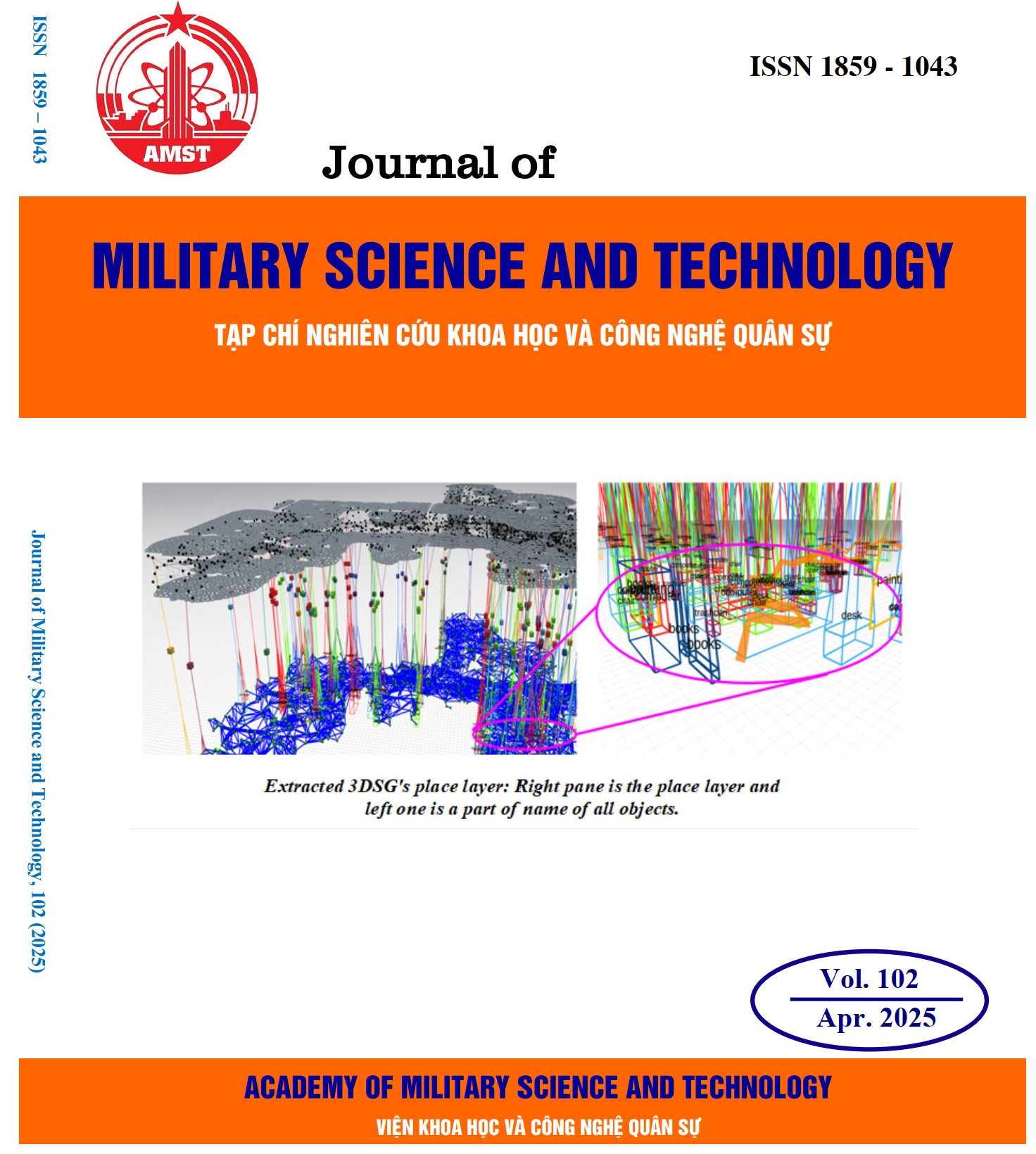RegC2P: Một mô hình sinh ảnh 3D-PET từ ảnh 3D-CT dựa trên GAN
417 lượt xemDOI:
https://doi.org/10.54939/1859-1043.j.mst.102.2025.125-132Từ khóa:
Dịch ảnh 3D; Chụp xạ hình 3D PET/CT; Chuyển ảnh CT sang PET; GAN; U-Net.Tóm tắt
Sự kết hợp giữa phương pháp Chụp cắt lớp phát xạ Positron (PET) và Chụp cắt lớp vi tính (CT) là bước tiến quan trọng trong lĩnh vực chẩn đoán ung thư bằng cách kết hợp thông tin chuyển hóa và giải phẫu, giúp cải thiện độ chính xác trong chẩn đoán, phân giai đoạn và theo dõi điều trị bệnh. Tuy nhiên, việc ứng dụng rộng rãi hệ thống PET/CT vẫn còn hạn chế do sự khan hiếm của máy quét PET và phương pháp chụp PET phụ thuộc vào phóng xạ. Để khắc phục vấn đề này, bài toán dịch ảnh 3D nổi lên như một giải pháp tiềm năng nhằm tạo ra ảnh PET tổng hợp từ ảnh CT. Tuy nhiên, các phương pháp sinh ảnh hiện có dựa trên Mạng sinh đối nghịch (GANs) gặp phải những thách thức như sự bất ổn định và ngẫu nhiên trong kết quả sinh, khiến quá trình chuyển đổi CT sang PET trong không gian 3D chưa đạt được độ chính xác mong muốn. Chúng tôi đề xuất RegC2P, một phương pháp mới tích hợp mô-đun đăng ký ảnh vào kiến trúc GAN để tạo ra ảnh PET 3D được căn chỉnh chính xác từ ảnh CT. RegC2P tiếp cận bài toán này theo hướng dịch ảnh 2D theo từng lát cắt, trong đó, mỗi lát cắt CT 2D được chuyển đổi thành lát cắt PET 2D tương ứng, sau đó xếp chồng để tạo thành ảnh PET 3D. Các lát cắt PET 2D bị căn chỉnh lệch được xem như nhãn nhiễu, và mạng sinh ảnh của RegC2P được huấn luyện kết hợp với mạng đăng ký để tự động hiệu chỉnh sai lệch, tối ưu hóa đồng thời cả hai nhiệm vụ dịch ảnh và căn chỉnh ảnh. Mặt khác, để đảm bảo độ mượt và tính nhất quán giữa các lát PET 2D được sinh ra trong toàn bộ khối ảnh 3D, chúng tôi đề xuất một mạng tinh chỉnh 3D U-Net. Các thí nghiệm trên tập dữ liệu lớn cho thấy RegC2P vượt trội hơn các phương pháp tiên tiến hiện nay, đạt giảm 10.16% MAE, tăng 0.96% SSIM và tăng 3.6% PSNR, từ đó thiết lập một tiêu chuẩn mới về chất lượng ảnh PET 3D tổng hợp từ mô hình Học sâu.
Tài liệu tham khảo
[1]. L. Wei and I. El Naqa, “Artificial intelligence for response evaluation with PET/CT,” in Seminars in Nuclear Medicine, vol. 51, pp. 157–169, Elsevier, (2021). DOI: https://doi.org/10.1053/j.semnuclmed.2020.10.003
[2]. S. R. Cherry, T. Jones, J. S. Karp, J. Qi, W. W. Moses, and R. D. Badawi, “Total-body PET: maximizing sensitivity to create new opportunities for clinical research and patient care,” Journal of Nuclear Medicine, vol. 59, no. 1, pp. 3–12, (2018). DOI: https://doi.org/10.2967/jnumed.116.184028
[3]. I. Goodfellow, J. Pouget-Abadie, M. Mirza, B. Xu, D. Warde-Farley, S. Ozair, A. Courville, and Y. Bengio, “Generative adversarial nets,” Advances in Neural Information Processing Systems, vol. 27, (2014).
[4]. P. Isola, J.-Y. Zhu, T. Zhou, and A. A. Efros, “Image-to-image translation with conditional adversarial networks,” in Proceedings of the 2017 IEEE Conference on Computer Vision and Pattern Recognition, pp. 1125– 1134, (2017). DOI: https://doi.org/10.1109/CVPR.2017.632
[5]. J.-Y. Zhu, T. Park, P. Isola, and A. A. Efros, “Unpaired image-to-image translation using cycle-consistent adversarial networks,” in Proceedings of the 2017 IEEE International Conference on Computer Vision, pp. 2223–2232, (2017).
[6]. H. Tang, D. Xu, N. Sebe, Y. Wang, J. J. Corso, and Y. Yan, “Multichannel attention selection GAN with cascaded semantic guidance for cross-view image translation,” in Proceedings of the 2019 IEEE/CVF Conference on Computer Vision and Pattern Recognition, pp. 2417– 2426, (2019). DOI: https://doi.org/10.1109/CVPR.2019.00252
[7]. K. Armanious, C. Jiang, M. Fischer, T. Kustner, T. Hepp, K. Nikolaou, S. Gatidis, and B. Yang, “Medgan: Medical image translation using GANs,” Computerized Medical Imaging and Graphics, vol. 79, p. 101684, (2020). DOI: https://doi.org/10.1016/j.compmedimag.2019.101684
[8]. Z. Liang, H. Wei, G. Liu, M. Cheng, J. Gao, S. Li, and X. Tian, “Leveraging GAN-based CBCT-to-CT translation models for enhanced image quality and accurate photon and proton dose calculation in adaptive radiotherapy,” Journal of Radiation Research and Applied Sciences, vol. 17, no. 1, p. 100809, (2024). DOI: https://doi.org/10.1016/j.jrras.2023.100809
[9]. Y. Zhu, Y. Tang, Y. Tang, D. C. Elton, S. Lee, P. J. Pickhardt, and R. M. Summers, “Cross-domain medical image translation by shared latent gaussian mixture model,” in Proceedings of the 23rd International Conference Medical Image Computing and Computer Assisted Intervention, pp. 379–389, Springer, (2020). DOI: https://doi.org/10.1007/978-3-030-59713-9_37
[10]. L. Kong, C. Lian, D. Huang, Y. Hu, Q. Zhou, et al., “Breaking the dilemma of medical image-to-image translation,” Advances in Neural Information Processing Systems, vol. 34, pp. 1964–1978, (2021).
[11]. D. T. Nguyen, T. T. Nguyen, H. T. Nguyen, T. T. Nguyen, H.-H. Pham, T. H. Nguyen, T. N. Truong, and P. L. Nguyen, “CT to PET Translation: A Large-scale Dataset and Domain-Knowledge-Guided Diffusion Approach,” Accepted for publication at the 2025 IEEE/CVF Winter Conference on Applications of Computer Vision, (2024). DOI: https://doi.org/10.1109/WACV61041.2025.00153
[12]. Xie, Huidong, et al. “DDPET-3D: Dose-aware Diffusion Model for 3D Ultra Low-dose PET Imaging.” arXiv preprint arXiv:2311.04248 (2023).
[13]. O. Ronneberger, P. Fischer, and T. Brox, “U-net: Convolutional networks for biomedical image segmentation,” in Proceedings of the 18th International Conference on Medical Image Computing and Computer-Assisted Intervention, pp. 234–241, (2015). DOI: https://doi.org/10.1007/978-3-319-24574-4_28







